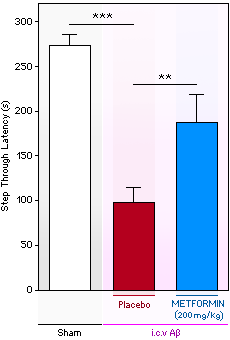unveiling neuroprotective potentials
Newsletter # 112

In vivo studies
Metformin(sold under brand names Glucophage, Fortamet, Riomet or Glumetza), widely recognized for its efficacy in managing type 2 diabetes, has attracted attention for potential neuroprotective benefits beyond glycemic control. Evidence, such as the review by Nowell et al. (2023)1, indicates a link between Metformin treatment and improved cognitive functioning in Alzheimer's disease (AD) or Parkinson's disease (PD) patients. These benefits may stem from Metformin's diverse actions, including reducing insulin resistance, modulating inflammation, activating AMP-activated protein kinase (AMPK), influencing amyloid-beta (Aβ) metabolism, and promoting neurogenesis, suggesting promising avenues for further exploration in the treatment of neurodegenerative disorders.
In preclinical studies conducted by Neurofit, rats receiving intracerebroventricular injections of Aβ, serving as an in vivo model for Alzheimer's disease, demonstrated significantly improved memory deficit when treated with Metformin. This suggests that Metformin's beneficial effects on cognitive dysfunction may be attributed to its interference with Aβ pathophysiology. Additionally, Metformin emerges as another antidiabetic agent, complementing previous findings with Semaglutide (also known as Ozempic) , by demonstrating effectiveness in Neurofit's preclinical AD model. This further bolsters the notion of the therapeutic potential of antidiabetic medications in addressing neurodegenerative diseases, as reviewed in reference1.
-

-
Enhanced memory performance in Aß-rats following Metformin treatment
The graph shows the recall performance of rats in the passive avoidance test.
Control rats (white column) still remember the previous aversive experience (electric shock) and avoid entering the dark chamber.
i.c.v. Aβ-rats (red column) forget the association between the context and the foot shock (hence shorter step through latency; white vs red column).
Treatment of i.c.v. Aβ-rats with Metformin enhances the recall of the context shock paired-chamber (hence, extended step through latency; red vs blue column).
Get in touch


 PREVIOUS
PREVIOUS